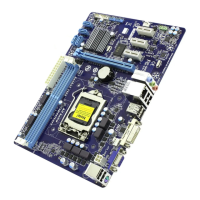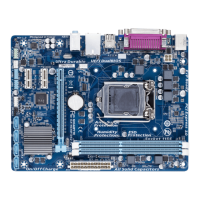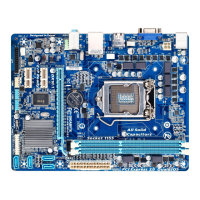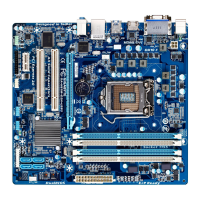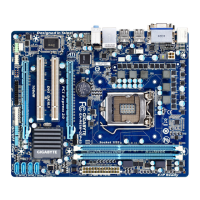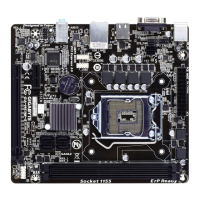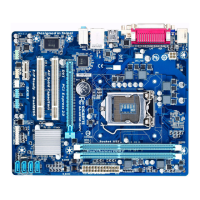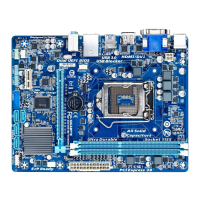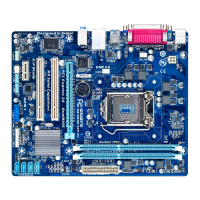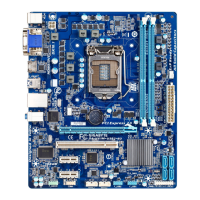Do you have a question about the Gigabyte GA-H61M-DS2 and is the answer not in the manual?
Lists the items included in the motherboard package for reference.
Essential safety guidelines and procedures to follow before installing hardware.
Detailed technical specifications of the motherboard components and features.
Step-by-step guide for safely installing the Central Processing Unit (CPU).
Instructions for installing DDR3 memory modules, including dual-channel configuration.
Guidelines for installing expansion cards into PCI Express slots.
Description of external ports located on the motherboard's rear panel.
Identification and purpose of internal headers and connectors on the motherboard.
Details on connecting the ATX 12V and 24-pin ATX main power connectors.
Information on connecting CPU and system fans to designated headers.
Description of SATA 3Gb/s connectors for storage devices.
Guide for connecting front panel switches, LEDs, and speaker to the motherboard.
Details on connecting front panel audio jacks for HD and AC'97 audio.
Instructions for connecting internal USB 2.0/1.1 ports via headers.
Information on legacy serial (COMA) and parallel (LPT) port headers.
Procedure for resetting BIOS settings to factory defaults using the CMOS jumper.
Explanation of the CMOS battery's function and replacement procedure.
Description of the screens that appear during the system's Power-On Self-Test (POST).
Overview of the main BIOS Setup utility interface and navigation.
Explanation of essential function keys for navigating and saving BIOS settings.
Advanced settings for CPU, memory, and voltage adjustments for performance tuning.
Detailed CPU core settings including clock ratios and turbo boost features.
Detailed configuration options for memory performance and timings.
Adjustments for CPU and DRAM voltages to optimize system stability.
Basic system settings such as date, time, and IDE/SATA device detection.
Advanced system settings related to boot order, security, and hardware features.
Enabling or disabling onboard devices like SATA, USB, Audio, and LAN.
Configuration of system power states, wake-up events, and power saving features.
Monitoring of system voltages, temperatures, fan speeds, and chassis intrusion.
Restoring the safest and most stable default BIOS settings for system stability.
Loading the optimal default BIOS settings for system performance and stability.
Setting up BIOS access passwords for system security and configuration control.
Saving current BIOS configuration changes and exiting the setup utility.
Exiting the BIOS setup utility without saving any configuration changes.
Accessing GIGABYTE's online technical support and service portal.
Lists the items included in the motherboard package for reference.
Essential safety guidelines and procedures to follow before installing hardware.
Detailed technical specifications of the motherboard components and features.
Step-by-step guide for safely installing the Central Processing Unit (CPU).
Instructions for installing DDR3 memory modules, including dual-channel configuration.
Guidelines for installing expansion cards into PCI Express slots.
Description of external ports located on the motherboard's rear panel.
Identification and purpose of internal headers and connectors on the motherboard.
Details on connecting the ATX 12V and 24-pin ATX main power connectors.
Information on connecting CPU and system fans to designated headers.
Description of SATA 3Gb/s connectors for storage devices.
Guide for connecting front panel switches, LEDs, and speaker to the motherboard.
Details on connecting front panel audio jacks for HD and AC'97 audio.
Instructions for connecting internal USB 2.0/1.1 ports via headers.
Information on legacy serial (COMA) and parallel (LPT) port headers.
Procedure for resetting BIOS settings to factory defaults using the CMOS jumper.
Explanation of the CMOS battery's function and replacement procedure.
Description of the screens that appear during the system's Power-On Self-Test (POST).
Overview of the main BIOS Setup utility interface and navigation.
Explanation of essential function keys for navigating and saving BIOS settings.
Advanced settings for CPU, memory, and voltage adjustments for performance tuning.
Detailed CPU core settings including clock ratios and turbo boost features.
Detailed configuration options for memory performance and timings.
Adjustments for CPU and DRAM voltages to optimize system stability.
Basic system settings such as date, time, and IDE/SATA device detection.
Advanced system settings related to boot order, security, and hardware features.
Enabling or disabling onboard devices like SATA, USB, Audio, and LAN.
Configuration of system power states, wake-up events, and power saving features.
Monitoring of system voltages, temperatures, fan speeds, and chassis intrusion.
Restoring the safest and most stable default BIOS settings for system stability.
Loading the optimal default BIOS settings for system performance and stability.
Setting up BIOS access passwords for system security and configuration control.
Saving current BIOS configuration changes and exiting the setup utility.
Exiting the BIOS setup utility without saving any configuration changes.
Accessing GIGABYTE's online technical support and service portal.
| Form Factor | Micro ATX |
|---|---|
| Chipset | Intel H61 |
| CPU Socket | LGA 1155 |
| Memory Type | DDR3 |
| Memory Slots | 2 |
| Max Memory | 16 GB |
| Memory Standard | DDR3 1333/1066/800 MHz |
| PCI Express x16 | 1 |
| PCIe 2.0 x1 | 1 |
| SATA 3Gb/s | 4 |
| USB 2.0 Ports (Rear) | 4 |
| USB 2.0 Ports (Internal) | 4 |
| Audio | Realtek ALC887 |
| LAN | Realtek GbE LAN chip (10/100/1000 Mbit) |
| Video Outputs | D-Sub |
| BIOS | AMI BIOS |
